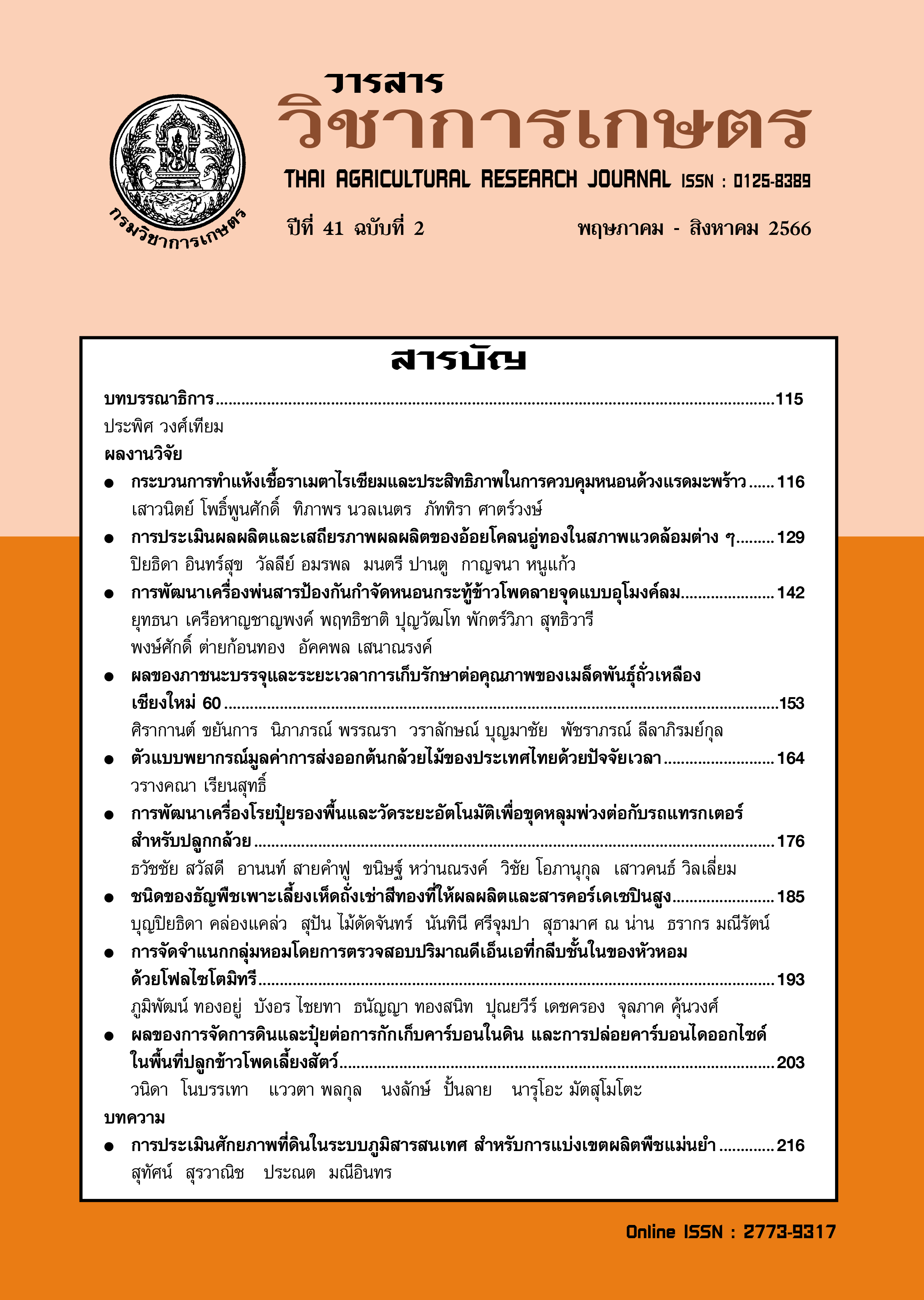ผลของการจัดการดินและปุ๋ยต่อการกักเก็บคาร์บอนในดิน และการปล่อย คาร์บอนไดออกไซด์ในพื้นที่ปลูกข้าวโพดเลี้ยงสัตว์
DOI:
https://doi.org/10.14456/thaidoa-agres.2023.18คำสำคัญ:
อินทรีย์คาร์บอนในดิน, ฟางข้าวคลุมดิน, ไม่ไถพรวน, สมดุลคาร์บอน, คาร์บอนไดออกไซด์บทคัดย่อ
การเพิ่มคาร์บอนอินทรีย์ในพื้นที่การเกษตรด้วยการกักเก็บคาร์บอนไว้ในดิน เป็นกลยุทธ์หนึ่งที่ช่วยบรรเทาการเปลี่ยนแปลงภูมิอากาศ และปรับปรุงความอุดมสมบูรณ์ของดิน ได้ศึกษาผลของการจัดการดินต่อการเปลี่ยนแปลงคาร์บอนอินทรีย์ในดิน (SOC) และการปล่อย CO2 ในพื้นที่ปลูกข้าวโพดเลี้ยงสัตว์ ที่แปลงทดลองระยะยาวในศูนย์วิจัยและพัฒนาเมล็ดพันธุ์พืชลพบุรี ในปี 2560-2563 วางแผนการทดลองแบบ RCB 8 กรรมวิธีจำนวน 3 ซ้ำ พบว่า กรรมวิธีใช้ฟางข้าวคลุมดิน ไถพรวน และใช้ปุ๋ยเคมีปล่อย CO2จากผิวดินเฉลี่ย 3.3 ตัน CO2/ไร่/ปีการใช้ฟางข้าวคลุมดิน เพิ่ม OC 3.0 ตัน C/ไร่ มากกว่าวิธีการไม่ใส่ปุ๋ยอินทรีย์ (2.5 ตัน C/ไร่) ส่วนวิธีการไถพรวนหรือไม่ไถพรวน การสะสม SOC ไม่แตกต่างกัน เช ่นเดียวกับวิธีการใส ่ปุ๋ยเคมี ไม ่ทำให้ SOC เพิ่มขึ้นแตกต่างจากการไม่ใส่ปุ๋ยเคมีผลการวิเคราะห์สมดุลคาร์บอนของวิธีการ ใช้ฟางข้าวคลุมดินไถพรวน และใช้ปุ๋ยเคมี คาร์บอนในดินลดลง 39-65 กก.C/ไร่/ปี การคืนกลับคาร์บอนจากเศษซากข้าวโพด-ถั่วเขียวลงในพื้นที่สูง 649-719 กก.C/ไร่/ปี เนื่องจากอัตราการเปลี่ยนคาร์บอนอินทรีย์ทั้งหมดไปเป็นคาร์บอนที่กักเก็บในดิน ไม่เพิ่มขึ้น จึงส่งผลให้คาร์บอนอินทรีย์ในดินลดลง ผลการศึกษานี้ ช่วยอธิบายถึงการเปลี่ยนแปลง
ของคาร์บอนในดินสภาพไร่ในเขตร้อนได้อย่างไรก็ตาม ควรศึกษาพลวัตคาร์บอนเพิ่มเติมในสภาพพื้นที่และสมบัติดินที่แตกต่างออกไป
เอกสารอ้างอิง
กลุ่มงานวิจัยเคมีดิน. 2544. คู่มือการวิเคราะห์ดินและพืช. เอกสารวิชาการ กลุ่มงานวิจัยเคมีดิน กองปฐพีวิทยา กรมวิชาการเกษตร. โรงพิมพ์ชุมนุมสหกรณ์การเกษตรแห่งประเทศไทย จำกัด. กรุงเทพฯ. 164 หน้า.
ยงยุทธ โอสถสภา. 2557. คุณภาพดินและสุขภาพดิน. หน้า 74-96. ใน: คุณภาพดินเพื่อการเกษตร. สมาคมดินและปุ๋ยแห่งประเทศไทย. 248 หน้า.
สถาพร ใจอารีย์ กิตติมา ศิวอาทิตย์กุล และ ชินพัฒน์ธนา สุขวิบูลย์. 2556. พลวัตรของคาร์บอนในดินภายใต้การ ไถกลบตอซังข้าวโพดของประเทศไทย. ว. อนุรักษ์ดินและน้ำ. 28(3): 20-31.
ศุภกาญจน์ ล้วนมณี วนิดา โนบรรเทา ดาวรุ่ง คงเทียน สุทัศนีย์ วงศ์ศุปไทย ศรีสุดา ทิพยรักษ์ ชยันต์ ภักดีไทย วัลลีย์ อมรพล พรพรรณ สุทธิแย้ม กอบเกียรติ ไพศาลเจริญ สมควร คล้องช้าง และคณะ. 2560. การสร้างธนาคารคาร์บอนในพื้นที่ปลูกพืชไร่และพืชทดแทนพลังงาน. รายงานโครงการวิจัยสิ้นสุดประจำปีงบประมาณ พ.ศ. 2560 กรมวิชาการเกษตร. 122 หน้า.
Amos, B. and D.T. Walters. 2006. Maize root biomass and net rhizodeposited carbon: An analysis of the literature. Soil Sci. Soc. Amer. 70(5): 1489-1503.
Anderson, J.P.E., A.L. Page, R.H. Miller and D.R. Keeney. 1982. Soil Respiration. pp 831-871. In: Page, A.L., Ed., Methods of Soil Analysis, Part 2 (2nd). ASA and SSSA, Madison.
Atkinson, C.J., J.D. Fitzgerald and N.A. Hipps. 2010. Potential mechanisms for achieving agricultural benefits from biochar application to temperate soils: a review. Plant Soil. 337:1–18.
Biederman, L.A. and W.S. Harpole. 2013. Biochar and its effects on plant productivity and nutrient cycling: A meta-analysis. GCB Bioen. 5: 202-214.
Fujisaki, K., T. Chevallier, L. Chapuis-Lardy, A. Alain, T. Razafimbelo, D. Masse, Y. Ndour and J.L. Chotte. 2018. Soil carbon stock changes in Tropical croplands are mainly driven by carbon inputs: A synthesis. Agri. Eco. Envi. 259: 147-158.
Ghimire, R., S. Lamichhane, B.S. Acharya, P. Bista and U.M. Sainju. 2017. Tillage, crop residue, and nutrient management effects on soil organic carbon in rice-based cropping system: A review. Integ. Agri. 16 (1):1-15.
Hazra, K.K., C.P. Nath, U. Singh, C.S. Praharaj, N. Kumar, S.S. Singh and N.P. Singh. 2019. Diversification of maize-wheat cropping system with legumes and integrated nutrient management increase soil aggregation and carbon sequestration. Geod. 353: 308-319.
Japan Soil Association. 2000. Methods of organic matter analysis-organic carbon. pp. 140-147. In: Methods of Organic Matter in Compost and Manure Analysis. Tokyo: Japan Soil Association (in Japanese).
Jarecki, M.K. and R. Lal. 2003. Crop management for soil carbon sequestration. Crit. Rev. Plant Sci. 22(6): 471-502.
Lal, R. 2003. Global potential of soil carbon sequestration to mitigate the greenhouse effect. Crit. Rev. Plant Sci. 22(2): 151-184.
Leghari, N., A.Q. Mughal, K.Q. Leghari, W. Farhad, M.S. Mirjat and H.M. Hammad. 2016. Effect of various tillage practices on soil properties and maize growth. Pak. J. Bot. 48(3): 1173-1182.
Limin, A., M. Shimizu, M. Mano, K. On, A. Miyata, H. Wada, H. Nozaki and R. Hatano. 2015. Manure application has an effect on the carbon budget of a managed grassland in southern Hokkaido, Japan. Soil Sci. Plant Nutr. 61(5): 856–872.
Ma, S., F. He, D. Tian, D. Zou, Z. Yan, Y. Yang, T. Zhou, K. Hung, H. Shen and J. Fang. 2018. Variations and determinants of carbon content in plants: a global synthesis. Biogeo.15: 693-702.
Mahmood, F., I. Khan, U. Ashraf, T. Shahzad, S. Hussain, M. Shahid, M. Abid and S. Ullah. 2017. Effects of organic and inorganic manures on maize and their residual impact on soil physico-chemical properties. Soil Sci. Plant Nutr. 17(1): 22-32.
Matsumoto, N., K. Paisancharoen and T. Hakamata. 2008. Carbon balance in maize fields under cattle manure application and no-tillage cultivation in Northeast Thailand. Soil Sci. Plant Nutr. 54(2): 77-288.
Matsumoto, N., W. Nobuntou, N. Punlai, T. Sugino, P. Rujikun, S. Luanmanee and K. Kawamura. 2021. Soil carbon sequestration on a maize-mung bean field with rice straw mulch, no-tillage, and chemical fertilizer application in Thailand from 2011 to 2015. Soil Sci. Plant Nutr. 67(2): 190-196.
Nelson, D.W. and L.E. Sommers. 1982.Total Carbon, Organic Carbon, and Organic Matter. pp. 595-579. In: Method of soil analysis, part 2. Chemical and Microbiology Properties. (2 nds) ASA-SSSA, Madison, Wisconsin, USA.
Nottingham, A.T., B.L. Turner, A.W. Stott and E.V. Tanner. 2015. Nitrogen and phosphorus constrain labile and stable carbon turnover in lowland tropical forest soils. Soil Biol. Biochem. 80: 26-33.
Parihar, C.M., M.D. Parihar, T.B. Sapkota, R.K. Nanwal, A.K. Singh, S.L. Jat, H.S. Nayak, D.M. Mahala, L.K. Singh, S.K. Kakraliya, et al. 2018. Long-term impact of conservation agriculture and diversified maize rotations on carbon pools and stocks, mineral nitrogen fractions, and nitrous oxide fluxes in Inceptisol of India. Sci. Total. Environ. 640-641: 1382-1392.
Rayment, G.E. and F.R. Higginson. 1992. Australian Laboratory Handbook of Soil and Water Chemical Methods. Inkarta Press, Melbourne, Australia. 330 p.
Shirato, Y., K. Paisancharoen, P. Sangtong, C. Nakviro, M. Yokozawa and N. Matsumoto. 2005. Testing the Rothamsted Carbon Model against data from long-term experiments on upland soils in Thailand. Eur, J. Soil Sci. 56(2): 179-188.
Sugino, T., W. Nobuntou, N. Srisombut, P. Rugikun, S. Luanmanee and N. Punlai. 2013. Effects of long-term organic material applications and green manure crop cultivation on soil organic carbon in rain fed areas of Thailand. Int. Soil Water Conserv. Res. 1(3): 29-36.
Thelen, K.D., B.E. Fronning, A. Kravchenko, D.H. Min and G.P. Robertson. 2010. Integrating livestock manure with a corn-soybean bioenergy cropping systems improves short-term carbon sequestration rates and net global warming potential. Biom. Bioen. 34: 960-966.
ดาวน์โหลด
เผยแพร่แล้ว
รูปแบบการอ้างอิง
ฉบับ
ประเภทบทความ
สัญญาอนุญาต
ลิขสิทธิ์ (c) 2023 วารสารวิชาการเกษตร

อนุญาตภายใต้เงื่อนไข Creative Commons Attribution-NonCommercial-NoDerivatives 4.0 International License.
วารสารวิชาการเกษตร



